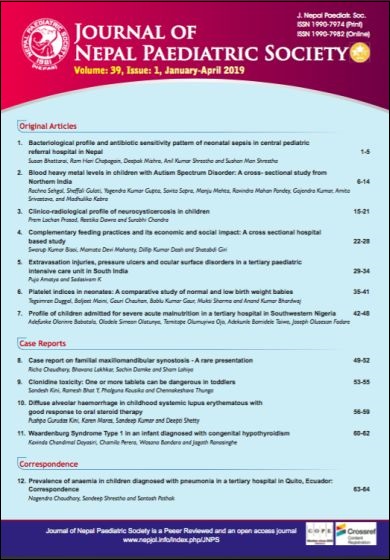Profile of Children Admitted for Severe Acute Malnutrition in a Tertiary Hospital in Southwestern Nigeria
DOI:
https://doi.org/10.3126/jnps.v39i1.21604Keywords:
Kwashiorkor, Marasmus, outcome, Marasmic-kwashiorkorAbstract
Introduction: This study assessed the socio-demographic profile, outcomes of treatment and challenges encountered in the management of children admitted for Severe Acute Malnutrition at the Paediatric Unit of a State University Teaching Hospital, Ado-Ekiti, Nigeria.
Methods: A retrospective cross-sectional study was conducted. The records of twenty-five children with SAM admitted from March 2013-March 2018 were reviewed. SAM was defined according to the Wellcome Classification based on child’s weight and oedema status. Data on demographic characteristics, presenting symptoms, co-morbid conditions, duration of admission and outcome were extracted.
Results: There were 13 (52.0%) males and 12 (48.0%) females. The median age of children with SAM was eight months. Eighteen children (72%) were marasmic, four (16%) had kwashiorkor while three (12%) had marasmic-kwashiorkor. Common presenting symptoms included poor weight gain (59.1%), fever (54.5%) and diarrhoea (36.4%). Majority (84.0%) of the patients had co-morbid conditions which included sepsis (66.7%), anaemia (37.5%), hypoglycaemia (16.7%) and hypothermia (16.7%). Twenty-one (84.0%) children were fully vaccinated for age, two (8.0%) had partial vaccination while two (8.0%) were never vaccinated. Only two (8.0%) had exclusive breastfeeding, 19 (76.0%) had mixed feeding from birth. Majority (60%) of the children had one or more social challenges such as teenage parents and financial constraints. Mean duration of admission was 4.56 days. Twelve (48.0%) left against medical advice, nine (36.0%) were discharged, one (4.0%) was referred to another tertiary facility and three (12.0%) deaths were recorded.
Conclusions: Many of the children admitted for SAM in our study had social problems and almost half of them left the hospital against medical advice. Besides health problem, social factors may play more role in SAM.
Downloads
Downloads
Published
How to Cite
Issue
Section
License
Authors who publish with this journal agree to the following terms:
Authors retain copyright and grant the journal right of first publication with the work simultaneously licensed under a Creative Commons Attribution License that allows others to share the work with an acknowledgement of the work's authorship and initial publication in this journal.
Authors are able to enter into separate, additional contractual arrangements for the non-exclusive distribution of the journal's published version of the work (e.g., post it to an institutional repository or publish it in a book), with an acknowledgement of its initial publication in this journal.
Authors are permitted and encouraged to post their work online (e.g., in institutional repositories or on their website) prior to and during the submission process, as it can lead to productive exchanges, as well as earlier and greater citation of published work (See The Effect of Open Access).



